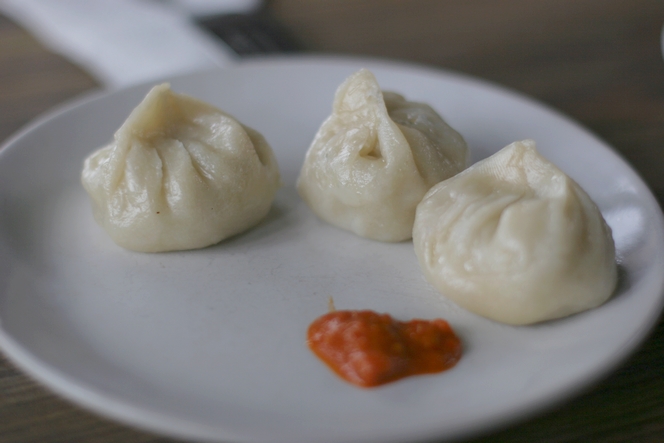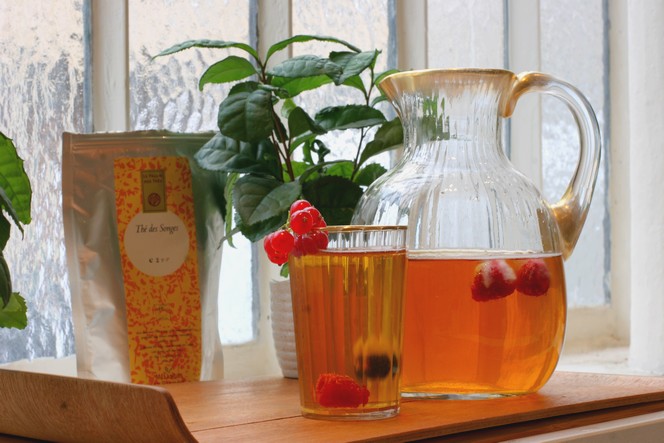What does a tea researcher do when he can no longer travel? He spends more time tasting teas, and trying new experiences! For a long time I’ve wanted to try infusing tea in sparkling water, and now I’ve done it. One hour at room temperature; I used Perrier on this occasion. The result was rewarding: a very refreshing and delicious drink, once I’d got over the surprise. Healthy, and with no added sugar. It’s at least as good as any fizzy drinks I’ve tried, and can be kept for 24 hours in the fridge. From left to right: Yuzu Tea, Genmaicha, Chai Imperial and Perles de Jasmin.
Recipes
Tea you can eat
Tea isn’t only drunk, it can be eaten too. In Myanmar, for example, lahpet, or lahpet thoke, is a national dish. It’s a salad made from fermented tea leaves to which are added vegetables, fruit, meat or dried shrimps, for example, as well as spices. It’s delicious!
Eggs with tea
If you’ve never cooked with tea, here’s a simple recipe to get you started: marbled eggs. It’s Easter, but we’re not talking chocolate. Instead, we’re using real eggs, so we’re sticking to the theme all the same. And of course, you can still use them for an Easter egg hunt for added fun!
Hard-boil your eggs, then place them in cold water. Gently crack the shell by tapping the egg lightly on all sides. Next, place the eggs into simmering water for 20 minutes along with 15g of Pu Erh Impérial (per 300 ml water), a stick of cinnamon, a tablespoon of soya sauce, two star anise and a pinch of salt. Then leave to cool. They can be kept, unpeeled, in the fridge for up to 48 hours.
Tea can be sprinkled over food
There are endless ways to use tea in cooking. For example, why not sprinkle it over food like a spice? Here, the aromatic, toasted, delicately woody and fruity notes of Jejudo Grand Oolong Impérial bring an exotic touch and a hint of crunch to this delicious burrata cheese. Sprinkle the tea over it and leave it in some green olive oil in the fridge for a couple of days. Enjoy it the Italian way: not too cold, as you sometimes see it served, but at a temperature of 20° to 22°C. To accompany it, infuse the same Korean tea in water at room temperature for 30 minutes and serve in small glasses such as vodka glasses.
Tea in your cocktails – a novel and delicious idea!
You can use tea in many ways. In cooking, if there is water, milk or single cream in a recipe, for example, you simply infuse the tea in the liquid and filter it. I’ll come back to that subject soon. You can also make cocktails with tea. If you’d like to try it, you can infuse tea directly in alcohol, though you may have to use more tea and steep it for longer. You can also prepare a strong tea in the usual way, and use it as an ingredient. Herbal infusions are also very good in cocktails. Philippe Carraz, head barman at the Alcazar, is pictured here mixing a delicious non-alcoholic cocktail made from agave syrup, fresh ginger, our Romantic Garden and a few sprigs of thyme. Let me know what you think.
Delicious iced tea
It’s summertime! I’d like to welcome you into the new season with a delicious iced tea. Steep your tea in water at room temperature and then chill in the fridge. Before serving, add a spoonful of honey, a slice of orange and perhaps a few mint leaves, and you will have a drink that is both delicious and refreshing.
There is nothing better than an iced tea to serve friends, young and old, like here on the veranda at Tomsong in Darjeeling. Here’s to tea!
In Darjeeling, momos are one of my favourite recipes
When I’m in Darjeeling, momos are one of my favourite recipes. For those who aren’t familiar with Himalayan typical food, it’s a steamed pastry filled with vegetables (“veg momos”) or minced chicken (“chicken momos”). As you can see, momos actually look quite similar to the Chinese Dim Sum.
Even before arriving in Darjeeling, when I’m on my way, I stop at the Tourist Lodge in Kurseong to eat a full plate of them. In Darjeeling, two famous Tibetan restaurants you could mistakenly take for greasy spoons, the Dekeva’s and the Kunga, have it as their specialty. A delight. Here are two recipes if you are interested, proportions change of course whether you serve them as an entry or as a main dish:
– Vegetarian momos (recettespourtous.com)
– Meat momos (Elle à table)
It goes without saying that you’re free adapting these recipes according to your tastes, replacing one meat by another, choosing different vegetables, overdo it with ginger. And adding chili to the tomato sauce to rouse the momo and make you, just by itself, imagine you here in Darjeeling!
Which tea to drink with it, you’ll ask me. I suggest a salted butter tea, ideally yacht butter, that you’ll have previously let go rancid just like Tibetans do.
Thé glacé: une boisson sans sucre, saine et désaltérante
Vendredi dernier, j’ai passé la journée dans ma salle de dégustation. Mais dans cette pièce d’habitude fraîche il faisait si chaud qu’après avoir dégusté un grand nombre de Darjeeling 2nd flush j’ai eu envie d’un thé froid. Je m’en suis préparé deux différents, car j’aime bien faire des comparaisons : un Thé des Songes ainsi qu’un Thé des Sables.
La recette du thé glacé est simplissime : vous mettez 15 grammes de thé à infuser dans un litre d’eau pendant 30 minutes, puis vous passez le thé à l’aide d’un passe-thé ou bien d’un filtre et c’est prêt ! Après cela, libre à vous de mettre la carafe ou la bouteille au réfrigérateur, si vous voulez un thé glacé plutôt qu’un thé froid. Au moment de servir, et comme suggestion d’accompagnement, quelques glaçons avec des fruits d’été pris dans la glace (myrtilles, framboises, groseilles) : c’est joli et gourmand.
Pour vous aider dans le choix des thés qui sont délicieux consommés froid, voici quelques uns de mes favoris : Bancha Hojicha, Grand Jasmin Chung Feng, Genmaïcha, Tie Guan Yin, Thé des Sables, Thé des Enfants, Thé du Hammam, Thé des Songes Blancs, ainsi que la plupart des thés parfumés à base d’agrumes ou de fruits rouges…
Bonne dégustation !
P.S. : sur la photo, juste derrière la carafe de Thé des Songes, l’un des petits théiers que l’on m’a offert au Japon en avril dernier. J’en prends grand soin et il me le rend bien : il a déjà doublé de taille !







